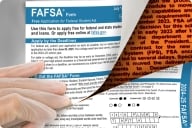You have /5 articles left.
Sign up for a free account or log in.
“Bias” is the word of the hour.
Today, we are acutely aware of an especially pernicious form of bias: that which is unconscious, unintentional and implicit, perpetrated by those who deny that they have a prejudiced bone in their body and are outraged when anyone implies that they are indeed bigoted or discriminatory.
Nor is implicit bias confined to medicine, policing or corporate workplaces. The academy has its own distinctive forms of systemic bias.
Disparate treatment is evident in hiring and promotion and tenure. It’s also apparent in the uneven incidence of harassment and access to administrative posts. Gender stereotypes color student teaching evaluations and departmental and institutional allocation of service responsibilities. Bias also impacts perceptions of competence and expertise and therefore whether a faculty member receives proper respect.
Unconscious bias also enters into the classroom, shaping faculty-student interactions, which can be welcoming and encouraging or anxious or even hostile.
To combat and uproot bias, colleges and universities have mandated diversity training, which, we’ve since discovered, has a very uneven impact and sometimes prompts resistance and a backlash.
As the science journalist Jessica Nordell reports in The End of Bias: A Beginning: The Science and Practice of Overcoming Unconscious Bias, this society is better at documenting bias than preventing discrimination or remediating its effects.
Unconscious bias, Nordell argues, is rooted not in malice or conscious prejudice, but in expectations: in the stereotypes, associations and generalizations that are a product of cultural myths, news stories and selective interpretations of personal encounters. Prejudice, in short, is absorbed, not, generally, something actually chosen.
“Biased individuals,” she writes, “do not see a person. They see a person-shaped daydream.”
Therefore, Nordell contends, the key to battling implicit or unintentional bias lies in mindfulness: helping individuals to become more self-conscious and reflective about the consequences of their perceptions, habits and behavior. To rewrite Freud’s dictum “where id is, there shall ego be,” we must replace automaticity with self-examination and conscious deliberation.
Among the strategies Nordell touts are diagnostic checklists used by physicians, mindfulness exercises used with some effectiveness by police forces, the removal of personal identifiers (in hiring decisions or in evaluating musicians) and “priming” individuals, implanting thoughts in their mind to alter their perceptions and induce empathy. The goal, in each case: to unlearn our instinctual responses and counter the tendency to make rapid decisions that too often express bias.
Nordell’s overarching message is optimistic: implicit bias can be overcome. Our perceptions and expectations are malleable. Collective norms and training can overpower our instincts and gut reactions.
Nordell’s emphasis on unconscious expectations tends to downplay other sources of implicit bias, including an impulse to maintain group solidarity or sustain hierarchy. Her interpretation also minimizes the emotional aversion that people might feel or their inability to identify with someone who they perceive as different.
In light of these other contributors to bias, we should not rely exclusively on mind-set training. We must also focus on policy and procedure.
Let’s take the example of bias in tenure decisions.
It is, of course, essential to require formal training about potential sources of bias for all faculty and administrators involved in the tenure-review process. But unlike the kinds of training that predominate today, the focus should be on specific, real-life examples of how bias has influenced tenure decisions.
If training is to work, it must not only increase awareness of bias’s prevalence, but instruct individuals to manage bias, create empathy, motivate inclusivity and lead them to track their behavior.
But training is not enough. The barriers to equity in access to tenure are not simply individual biases that minimize the value of a tenure candidate’s scholarship, teaching effectiveness or service contributions. The obstacles are bigger; they’re systematic and structural, and include:
- Fuzzy tenure expectations and criteria.
- Inequities in start-up packages and access to grants and research support.
- Departmental cultures that are unwelcoming or isolating and that have a negative impact on job satisfaction, productivity and retention.
- Tenure expectations that presume that a candidate has no work-life challenges.
Eliminating these barriers, it’s widely agreed, requires institutions to take the following steps:
1. Provide transparency and clarity in tenure requirements and expectations.
A department must make sure that all tenure-track faculty are well informed about the tenure process and tenure expectations.
2. Work with the candidate from the moment of hiring to devise a road map to tenure.
Assist junior faculty in creating a personal career development plan that identifies milestones to be met to achieve a successful third-year review. Take the third-year review seriously and during their probationary period provide faculty with a clear picture of their progress toward tenure.
3. Do more to support junior faculty professional development.
Offer workshops, organize discussion groups and provide mentoring and networking opportunities to support tenure track faculty.
A grant program targeting junior faculty can strengthen these candidates’ scholarly credentials and support them as they develop new courses and build their professional network.
Also, consider establishing an office of faculty career development services to assist faculty who are applying for tenure and promotion, for example, in preparing a tenure dossier. This office might also assist departments in establishing supportive work environments and help them retain diverse faculty.
4. Ensure equal opportunity to achieve tenure.
Provide equal start-up packages and family-friendly accommodations and, when appropriate, modify service duties and teaching assignments or permit a junior faculty member to stop the tenure clock.
5. Ensure clarity, transparency and consistency in the tenure-review process.
Create rubrics and criteria for evaluating scholarship, teaching and service.
6. Strengthen accountability and oversight of the tenure process.
Assign a person to discover procedural errors and monitor compliance with institutional rules.
7. Create formal mechanisms to spot bias within a department.
Use surveys and focus groups to identify positive and negative aspects of a department’s culture. Also, monitor every department’s progress toward achieving the campus’s diversity, inclusion, equity, retention and promotion goals.
8. Consider broadening the criteria for tenure along the lines that Ernest Boyer suggests: to include the scholarship of application, of engagement and of teaching and learning.
In addition, make sure that service and teaching contributions (including contributions to curricular diversity, mentoring, recruitment and outreach) are given appropriate weight.
Countering bias is an institutional imperative. But be aware: there is no easy fix. Diversity training, on its own, isn’t enough.
Can antibias training successfully draw attention to various manifestations of bias? Of course. Can it challenge stereotyping and call out prejudice? To a certain degree. Can it solve your institution’s diversity and inclusion challenges? No.
Bias within the academy (and elsewhere) is not just an attitudinal problem or a matter of consciousness raising. It’s, first and foremost, a structural and organizational problem that requires changes in the ways institutions operate.
Steven Mintz is professor of history at the University of Texas at Austin.







